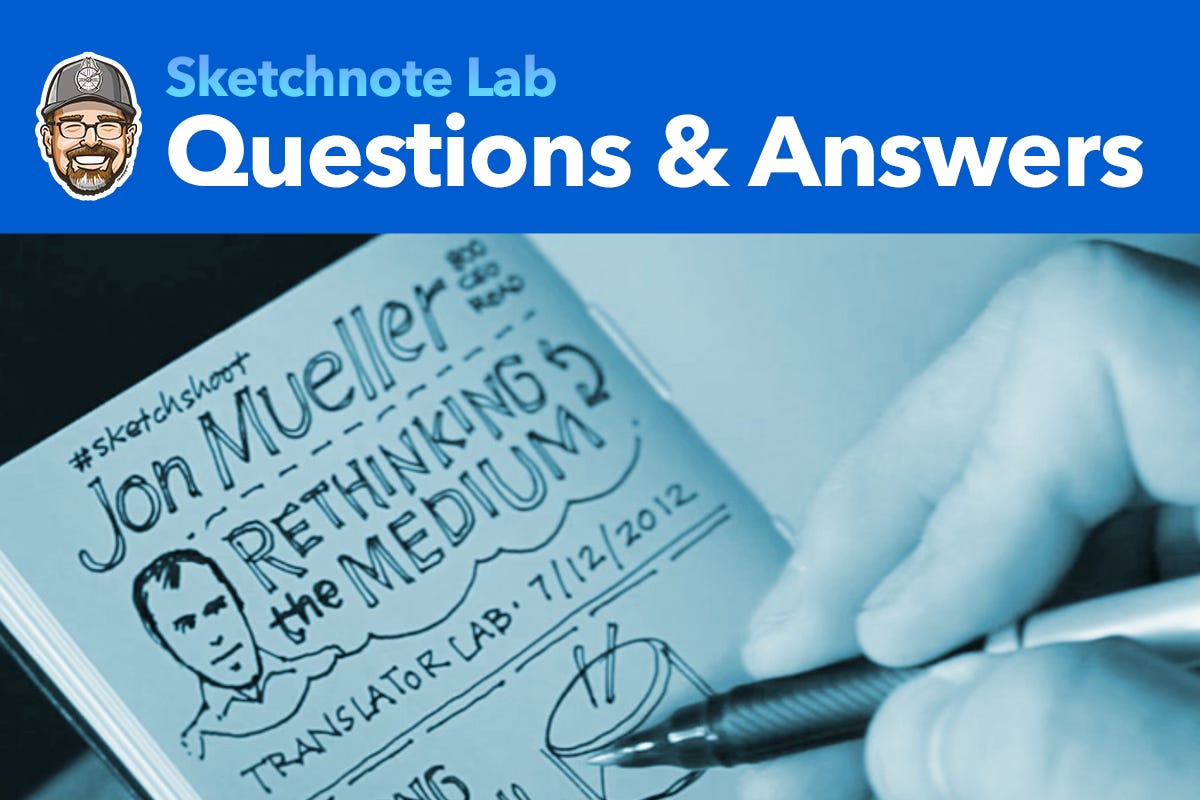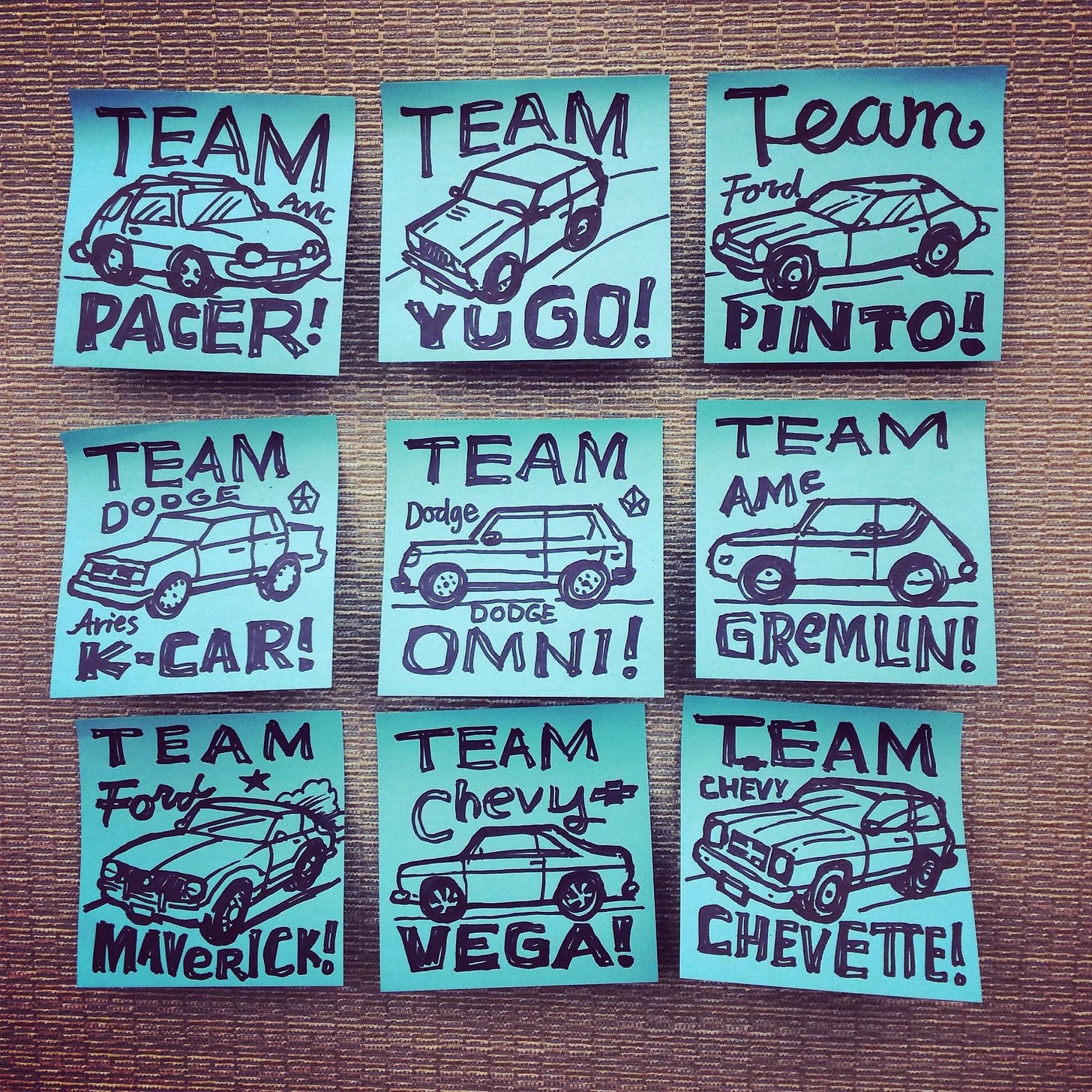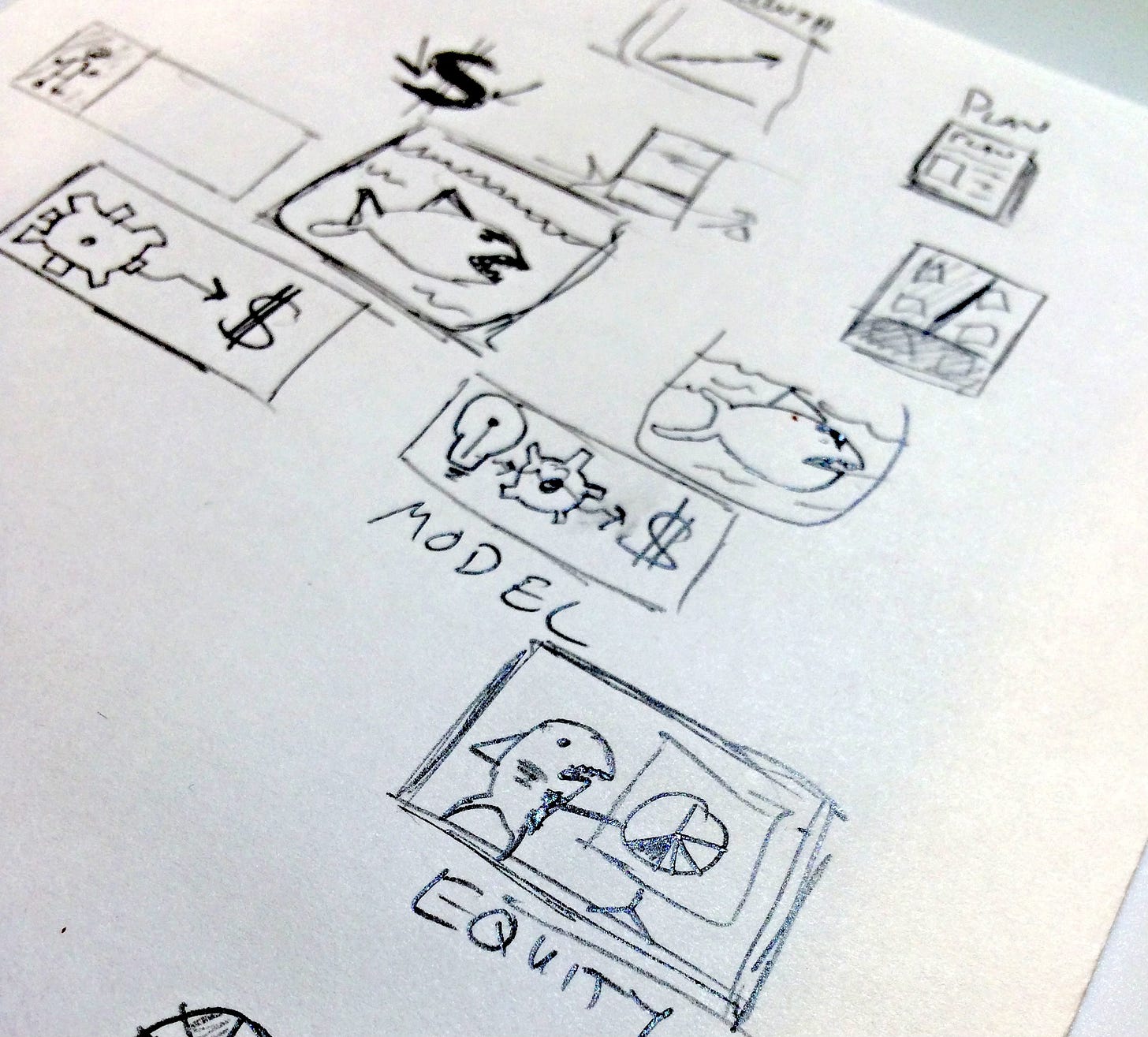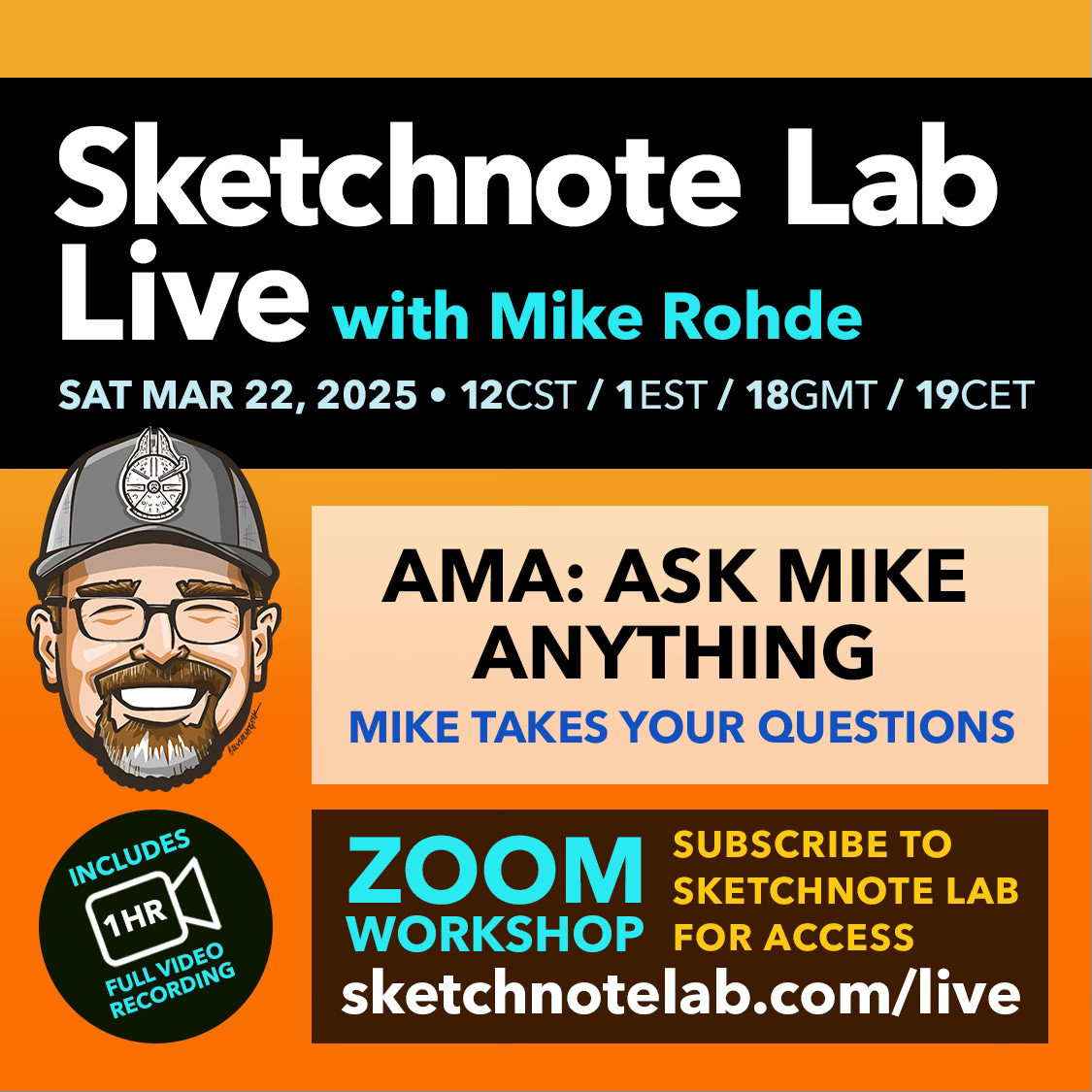Sketchnote Lab Q&A: How do I facilitate and sketchnote simultaneously?
The first in a series of Q&A posts based on readers' questions to help other Lab Members. Plus, the Ask Mike Anything AMA is coming Saturday, March 22nd!
To start things off, here’s a question from Lab Member Dale Towner:
“Having the time to capture information as it happens—especially in planning, working, or knowledge sharing meetings is challenging.
Conversations move so fast that they’re difficult to capture. Given that my role is to facilitate, this adds a level of focus that makes me terrible at both, so I default to facilitating.
Dale, great question! I’ll offer some answers and ideas.
1. Simultaneously facilitating and visualizing is an elite-level skill that requires practice.
In my experience, a small group of talented people can simultaneously facilitate a group AND sketchnote or visually record that session. It is VERY HARD TO DO!
Why? Listening closely to a group’s words, managing the personalities in the group, keeping a group on track, and creating coherent visuals simultaneously can put a heavy cognitive load on one person. It’s hard work that comes with practice.
Even the wizards who can perform this dual magic have limits on how fast they can process information, facilitate a group, and visualize what everyone is saying. Every wizard must strike a compromise between facilitation and visuals.
My friend Peter Durand of Alphachimp, a professional graphic recorder and visual facilitator (a wizard), has a few thoughts about these elite skills:
”Any ‘elite’ skill is evolved through practice, learning on the fly, and evolving one's survival skills. The delusion that we must be ‘ready’ before jumping in often holds us back.”
So, learning and practicing these skills and attaining elite status is possible!
2. Facilitation and visualization are typically two separate jobs performed by a team of two.
Because mastering this dual skill is so challenging, professional facilitators often choose a trusted graphic recorder to capture the visuals so they can focus entirely on facilitating.
In the same way, professional graphic recorders will choose trusted facilitators to handle facilitation so they can focus on visually capturing what the group says.
Having two sets of eyes and ears can help manage complex topics and large groups.
Facilitation is about group progress. Here’s Peter again:
”Facilitation is about helping groups make progress. All writing and visuals serve progress, not perfection. Clear, bold handwriting always beats fancy drawing skills.”
Here are five ideas to help you manage facilitation with sketchnoting in meetings while building your skills.
→ Clearly Define the Meeting Agenda
If you know the topics ahead of the meeting (which you may not), you can set a tight agenda on what you will discuss. This provides you with a limited set of things to work with when you are live in the meeting that could help.
When I did whiteboard sketchnotes with an agile team, we always had a clear agenda before we started and emailed team members so they knew what to expect, which limited where the discussion could go.
→ Use Templates to Constrain Information
If you know the topics beforehand, using a template is another way to constrain information. A simple map with four areas that define your information could help you and the team break down the ideas into themes.
Here are a few templates to get you started:
The Eisenhower Matrix helps divide ideas into urgent and important quadrants.
Empathy Map Canvas from XPLANE and Dave Gray.
The Business Model Canvas from Alec Osterwalder at Strategyzer.
→ Use Sticky Notes to Capture Quickly
You can also sketch on sticky notes quickly and place them on the board to cache information until you have time to sketchnote it. Having this buffer system helps you focus on information capture first.
You can represent a sticky note idea with a sketchnote in more detail in the live meeting or add it after the fact if the final work is a reference to be shared with the group as a summation.
→ Invite the Group to Visualize Their Ideas on Sticky Notes
You can also invite group members to write or visualize their ideas on sticky notes with the five basic shapes (square, circle, triangle, line, and dot).
This can engage them in gathering group ideas and feedback and offload the processing to many instead of just little old you.
“Put the audience to work! The more content they create, the higher the engagement, the more authentic the output, and the more relevant and sticky the results will be.
Using the sticky notes you all create, you can organize them in logical groupings and look for themes that are bubbling up.
When you finish the meeting, you could go one more step (if needed) to corral all of those stickies into a visual sketchnote without the pressure to perform live.
→ Build an Icon Library
You'll have unique concepts in your group's domain (law, business, technology, and so on) that you can use to build an icon library. This could be a great group exercise, where you capture icon ideas and choose the final icons as a team.
These icons could be captured on sticky notes and gathered in a reference sheet you create. Each team member would receive it either printed or on the network.
Final Thoughts
Juggling facilitation and sketchnoting is an advanced skill that requires focus and experience, but you can learn these skills with practice.
Clearly defining the agenda, using templates, leveraging sticky notes, and creating an icon library can make the process more manageable.
Experiment with these ideas in your next group meeting!
Live Lab for March: Ask Mike Anything!
This month’s Live Lab Session will be an AMA-style, Ask Mike Anything session on March 22, 2025. I’d love to answer your questions or give feedback on your sketchnotes in this live AMA session for Paid Lab Members.
I’d love for you to send me:
Questions about sketchnoting: practice, places you’re stuck, etc.
Sketchnotes or visual work you would like my feedback on
Please post your questions or work to be reviewed in the chat.
I will gather these and work through as many questions or sketchnote samples as possible in our 1-hour time slot, and of course, the video replay will be posted the following week for Paid Lab Members.The session will be recorded for Paid Lab Members, so even if you can’t attend, submit your questions and watch the answers in the replay.
Thanks again for the chance to share something fun in your inbox!
— Mike
Sketchnote Lab is Mike Rohde’s space designed to bridge the gap between sketchnote theory and practice. The goal is to guide you in integrating sketchnoting into your everyday life. Learn more about Sketchnote Lab.
Mike is the author of The Sketchnote Handbook and The Sketchnote Workbook, bestselling books that teach regular people how to start and keep sketchnoting.
He founded the Sketchnote Army and hosts the Sketchnote Army Podcast, where he interviews visual thinkers to understand what makes them tick.
Mike offers recorded, live, and in-person workshops to help accelerate your sketchnoting practice and coaching for personalized, 1:1 sketchnoting guidance.
Become a paid Lab Member to support Mike’s work.









